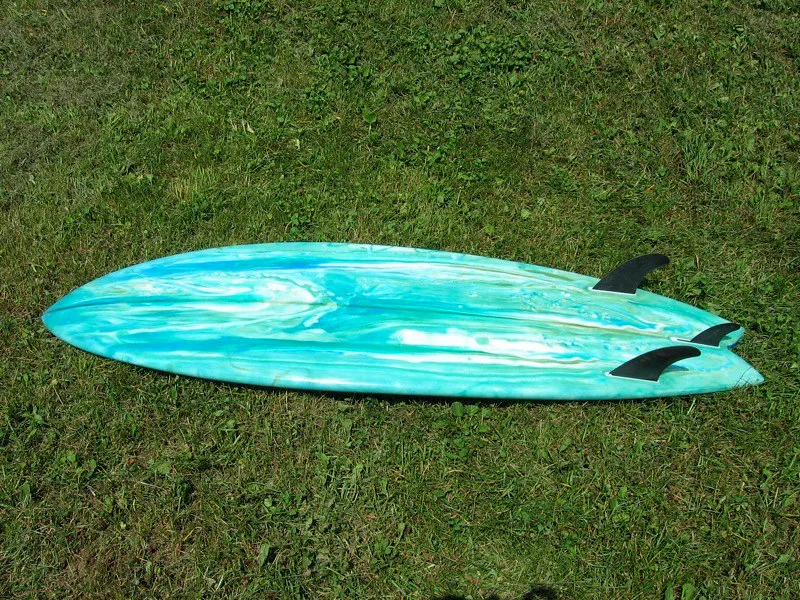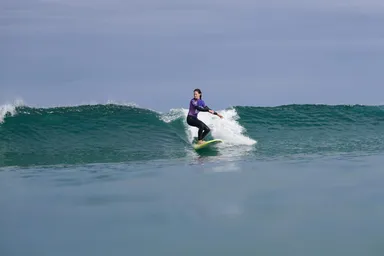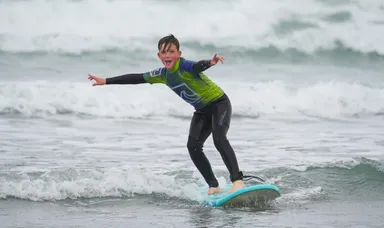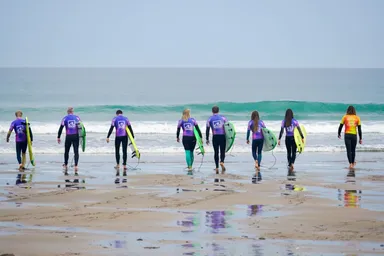Understanding Surfboard Fin Setups
Understanding Surfboard Fin Setups
Understanding surfboard fin setups- what they are and when to use them- can be tricky for novice surfers. As you progress as a surfer, you might start to think about experimenting with the fins you use.
Most surfboards come as standard with three fins, set up in a triangle-like formation, which is known as a 'thruster' set up.
However, there are several other ways to set up your surfboard fins, and you may opt for a different setup depending on:
- what board you ride
- what surf conditions you are in
- what style of surfing you prefer
In this guide, we'll walk you through the different fin setups you can use for your surfboard and when you might want to use them as an improver surfer.
Single Fin Setup
Fun fact: Originally a concept coined by Tom Blake in 1935 when he attached a fixed keel fin from a small speedboat to the tail of his board for better stability and control in the surf.
When to use:
Nowadays, single fins are usually found on longboards, but more recently have made an appearance on midlengths as well. Also some foamies such as the Vision softboards that we use at OA Surf Club come as a single fin set up.
Pros and cons:
Single fins are characterised by heightened speed in the surf due to lack of drag. They also offer lots of control, predictability and stability for 'down the line' surfing. They work well with a smoother and slower turning style, however because of this they can be tricky when it comes to learning to turn for novice surfers.
Size guide:
As a general rule, the length of the single fin wants to be the same size in inches as the board is in feet. I.e a 9ft longboard would take a 9" fin. However for beginner surfers and those looking for more control on the board, you can add an inch (i.e. 9ft board + 10" fin).
Twinny (Twin Fin) Setup
Fun fact: Using a twin fin fish, Mark Richards went on to win four consecutive World Championships (beating the other competitors- all riding single fins!).
When to use:
They can often be found on shorter boards with thicker rails, for example fishes.
Pros and cons:
The twin set up really shines in smaller, messier swell due to the increased speed they produce and the increased ability to control and manoeuvre the surfboard. They also allow more experienced surfers to take lines they would not normally find when surfing, and encourage the use of rail surfing.
Size guide:
Usually found as large or extra-large. Those on the smaller side might opt for large, with bigger individuals opting for extra-large. Personal preference can still play a factor here however.
Thruster Setup
Fun fact: this set up was created in 1980 by Australian surfer Simon Anderson, as he found a need for more 'hold' with high performance surfing in bigger waves.
When to use:
Characterised by three equal-sized fins in triangle formation, this set up is the most common configuration found in modern day surfing. Thruster set ups can be found on most surfboards, from foamies right the way to performance short boards.
Pros and cons:
Thrusters are ideal for performance surfing. This set up provides increased control and manoeuvrability thanks to the centre fin creating more drag. They also shine in steeper, larger swell and are even the optimum choice for barrel riding.
Size guide:
Generally speaking the sizing of thruster fins runs in accordance with the weight of the surfer. There are many size guides out there than can help beginner surfers know which size to opt for. However, in particular conditions, or simply due to personal preference, surfers may choose smaller or larger fins. It is recommended to start at the size guide point and then experiment around that to find what works best for you.
Quad Setup
Fun fact: The story goes that Glen Winton, a New South Wales native and Aussie Surfriders champion in 1981 and 1982, began riding six-fin surfboards before “knocking two of ’em off,” thus becoming widely recognized as the forefather of the quad!
When to use:
Quad fins provide a marriage of some of the characteristics of both thruster and twin fin set ups. They are excellent for speed, as well as quick and sharp manoeuvres. This makes the quad fin set up really shine in small-medium waves. While a tricky set up for novice surfers, this set up is a great choice for more progressive surfing as it allows for speed and hold when taking higher lines.
Pros and cons:
Given the lack of drag from a centre fin, they provide almost unparalleled speed in the surf, making them an excellent choice for great for tubes and more powerful waves. They also provide excellent manoeuvrability in the surf making progressive turns more accessible. However, they can be a big adjustment from surfing a thruster, so you may find that when you first try out surfing with quad fins that the learning curve is steeper, and progression may take time.
Size guide:
Similar to thruster in that it depends on the weight of the surfer and the feel you want out of the fins- bigger fins will provide more hold, smaller ones provide a 'looser' feel to your surfing. With a quad fit set up, the rear fins should be a bit smaller, 1/2 of an inch, with possibly a little less rake. The position of the fins in the board will also alter the feel when surfing, which is also worth bearing in mind.
2+1 Setup
Fun fact: The two smaller fins on the sides are known as 'side bites'!
When to use:
The 2+1 set up is similar to a thruster in the sense that it incorporates three fins in a triangle formation. However, it is unique in that the centre fin is larger than rail fins (referred to as 'side bites'). The smaller rail fins provide lift, control and stability when surfing on rail, in contrast to a traditional single fin set up. 2+1 fin set ups are generally found on longboards as an alternative to single fins, and they are not generally found on shortboards/ fishes etc.
Pros and cons:
While this set up provides greater control for longboards, comparative to a standard single fin, it also creates more drag, so speed is sacrificed somewhat.
Size guide
As a general guide, as the size of your centre fin increases, the size of your side bites can decrease, and vice versa.
Conclusion
There are many different set ups you can use for your surfboard fins- not all of them even mentioned in this article! The best way to figure out what kind of fin set up you like, and what you want to surf on, is to simply try them out. Borrowing from a friend, or renting from a surf shop, are great option to play around and figure out what works for you without having to invest, and run the risk that you throw money on a set up you actually hate.
If you're considering altering the fin set up of your surfboard, or aren't sure if what you're riding right now is best for your style, you can always book a surf lesson and work with an experienced coach to figure out what works best for you.
Remember though- no matter what set up you use, so long as you're having fun out in the water, then it's a great set up regardless!








